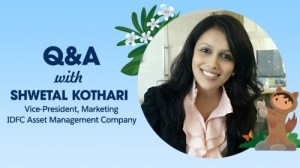Online customer engagements have seen a rise in the recent past. Digital-first customers demand great experiences and meaningful conversations. However, brands often find it tough to stand out from the noise that surrounds online channels.
So, how can businesses think digital-first to succeed in the new age? Can Chief Marketing Officers (CMOs) efficiently plan communication in a hyper-personalised manner for each customer? Shwetal Kothari, Vice President of Marketing, IDFC Asset Management Company Limited (IDFC AMC) shares her take on the CMO’s changing role and the need for context in every interaction.

How are customers engaging with brands today, and what does this mean for the new-age CMO?
Kothari: Brands all over the world have taken digital to an all-new level over the last few months. We are seeing consumers across age groups adapting to new digital behaviours. They want to imbibe these as a part of their day-to-day lives. So, businesses must think Digital First—in every sense.
Going forward, every customer interface will be digital-first. This is where the marketer’s role becomes extremely critical. We are the business drivers of this transformation. CMOs must proactively identify the needs of customers in such times and fulfil them through our communication and content. As CMOs, we must unlearn our past experiences, and adapt to the new digital age and changes in customer behaviours. While content is King, context is the Queen. You must sound relevant as a brand. Your communication must make a difference.
Today, the key to building long-lasting relationships with customers lies in having meaningful conversations with them. There is a barrage of information out there, being thrown at the customer. You need to break through that noise and clutter to truly engage them and win their loyalty. And I feel you can do that with hyper-personalisation, where your meaningful content can make a difference in the customer’s life on a day-to-day basis.
How does IDFC Asset Management engage with customers from a hyper-personalised perspective?
Kothari: At IDFC Asset Management, technology plays a lead role—not just for our external customers who invest with us, but also our internal customers – our partners – who look after our customers’ financial planning and wealth management. Our initiatives centre around data-based interactions that can enable sales process improvements and new cross-sell strategies.
Let me give you the instance of monthly cross-sell and upsell campaigns for our existing investors. The traditional approach relies on the use of just the customer’s portfolio holdings to make product recommendations. This can be a hit-or-miss approach. In our case, we use data analytics models to understand industry behaviour, market trends, and the investor’s past purchase behaviour. This provides predictive analysis about what a customer is most likely to buy. Or what the next best action for this customer could be, even if that means this investor should continue with their current investment products and not buy from you.
In many cases, such capabilities save you from providing irrelevant advice and allow you to truly think about what the customer’s actual need is – not just what you want to push to them. The power of data and hyper-personalisation come into play here. You are able to interact with your customer using timely advice, with the right kind of information.
Another example is how we create a smooth transaction experience for our customers. Use of the Salesforce platform and personalised journeys created on the platform ensure that customers coming to our website have an uninterrupted experience—they don’t need to fill in data already available with us. We minimise customer inputs and lead them through a quick transaction process.
Could you share more details on the success you have seen? And how you use technology to engage with your customers?
Kothari: It is important that you reach out to your customer with the same message across different touchpoints. And these messages must come across as more of a soft nudge than a hard sell. At IDFC Asset Management, we do not want to come across as a brand that is trying to sell its products to the customer; we want to be their partners on their wealth creation journey. Through our communication with them, we want our customers to understand the long-term benefits of whatever we recommend.
For consistent, omnichannel communication, we use Salesforce Advertising Studio. Our most recent campaign using Advertising Studio has been for our customers whose Systematic Investment Plans have expired with us. We have been able to create a unified customer journey, orchestrating the entire experience—right from the time we send e-mails and SMS, all the way to targeted ads on social media.
The fact that we are sending out uniform and personalised, contextualised messaging has actually resulted in an overall improvement in open and click rates. We also saw a significant reduction in the overall unsubscribe rates.
Using Salesforce Marketing Cloud’s analytics, we have also been able to analyse the performance of these campaigns. This has enabled us to make our communication more targeted and meaningful. As a result, we have witnessed an increase in our sales by up to 3x. Our story is one example of what is possible when technology meets marketing.
As CMOs tune their marketing efforts to enhance customer experience, contribute more strategically to business revenue, and think digital first, choosing the right technology will be critical. Real-time insights, accurate predictions, omnichannel data analysis, and integrated sales and marketing goals will be every CMOs must-have(s).
Find out how the role of the CMO is evolving in these new times and how data-driven technology solutions can help you to create winning customer engagements and superlative experiences that will set you up for growth.
Download our e-book ‘The Marketer’s Playbook for Success in a Post-Covid World.’

























